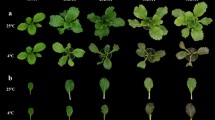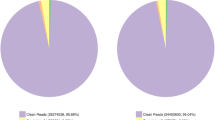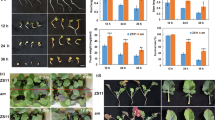Abstract
Anthocyanins are natural bioactive pigments in plants that play important roles in many physiological functions. They are found in various tissues and can protect plants against different stress conditions. Anthocyanins are synthesized and accumulate in nutritional organs, which is crucial for plants to adapt to and resist adverse environmental conditions, including high exposure to light, ultraviolet light, low temperatures, drought, pests and disease. Some progress has been made in understanding the adaptability of anthocyanin to the external environment. Begonia semperflorens is an excellent model for studying the function and regulation of anthocyanin synthesis. To investigate the biosynthesis and regulation of anthocyanins, RNA sequencing techniques were employed to investigate anthocyanin biosynthesis induced by low temperature in B. semperflorens leaves. A total of 74,779 unigenes with a mean length of 1249 bp were assembled. Functional annotations were implemented using five protein databases. Differentially expressed genes involved in the process of anthocyanin biosynthesis were identified. This study represents the first report of a broad-scale gene expression study on B. semperflorens.





Similar content being viewed by others
Abbreviations
- WBM:
-
WD40-bHLH-MYB
- UFGT:
-
Flavonoid 3-O-glucosyltransferase
- LT:
-
Low temperature
- CK:
-
Control
- COG:
-
Clusters of orthologous groups
- GO:
-
Gene ontology
- KEGG:
-
The Kyoto Encyclopedia of Genes and Genomes
- DEGs:
-
Differentially expressed genes
- Nr:
-
Non-redundant
- FDR:
-
False discovery rate
- 4CL:
-
4-Coumarate: Coenzyme A Ligase
- ANS:
-
Anthocyanidin synthase
- CHI:
-
Chalcone isomerase
- CHS:
-
Chalcone synthase
- DFR:
-
Dihydroflavonol 4-reductase
- GST:
-
Glutathione S-transferase
- PAL:
-
Phenylalanine ammonialyase
- ROS:
-
Active oxygen free radicals
References
Altschul SF, Madden TL, Schaffer AA, Zhang J, Zhang Z, Miller W, Lipman DJ (1997) Gapped blast and psi-blast: a new generation of protein database search programs. Nucleic Acids Res 25:3389–3402
Amin HP, Czank C, Raheem S, Zhang Q, Botting NP, Cassidy A, Kay CD (2015) Anthocyanins and their physiologically relevant metabolites alter the expression of IL-6 and VCAM-1 in CD40L and oxidized LDL challenged vascular endothelial cells. Mol Nutr Food Res 59(6):1095–1106
Anders S, Huber W (2010) Differential expression analysis for sequence count data. Genome Biol 11:R106
Broberg P (2005) A comparative review of estimates of the proportion unchanged genes and the false discovery rate. BMC Bioinform 6:199
Cheng DD, Zhang ZS, Sun XB, Zhao M, Sun GY, Chow WS (2016) Photoinhibition and photoinhibition-like damage to the photosynthetic apparatus in tobacco leaves induced by Pseudomonas syringae pv. Tabaci under light and dark conditions. BMC Plant Biol 16(1):29–39
Fogelman E, Tanami S, Ginzberg I (2015) Anthocyanin synthesis in native and wound periderms of potato. Physiologiaplantarum 153(4):616–626
Golding J, Wasshausen DC (2002) Begoniaceae, edition 2: part I: annotated species list: Part ii: Illustrated key, abridgment and supplement. Contrib U S Natl Herb 43:1–289
Grabherr MG, Haas BJ, Yassou M, Levin JZ, Thompson DA, Amit I, Adiconis X, Fan L, Raychowdhury R, Zeng Q, Chen Z, Mauceli E, Hacohen N, Gnirke A, Rhind N, Palma F, Birren W, Nusbaum C, Lindblad-Toh K, Friedman N, Regev A (2011) Full-length transcriptome assembly from RNA-Seq data without a reference genome. Nat Biotechnol 29:644–652
Huang ZA, Zhao T, Fan HJ, Wang N, Zheng SS, Ling HQ (2012) The upregulation of NtAN2 expression at low temperature is required for anthocyanin accumulation in juvenile leaves of Lc-transgenic tobacco (Nicotiana tabacum L.). J Genet Genom 39:149–156
Kanehisa M, Araki M, Goto S, Hattori M, Hirakawa M, Itoh M, Katayama T, Kawashima S, Okuda S, Tokimatsu T, Yamanishi Y (2008) Kegg for linking genomes to life and the environment. Nucleic Acids Res 36:480–484
Li B, Dewey CN (2011) RSEM: accurate transcript quantification from RNA-Seq data with or without a reference genome. BMC Bioinform 12:323
Lingua G, Bona E, Manassero P, Marsano F, Todeschini V, Cantamessa S, Copetta A, D’Agostino G, Gamalero E, Berta G (2013) Arbuscular mycorrhizal fungi and plant growth-promoting pseudomonads increases anthocyanin concentration in strawberry fruits (Fragaria × ananassa var. Selva) in conditions of reduced fertilization. Int J Mol Sci 14(8):16207–16225
Livak KJ, Schmittgen TD (2001) Analysis of relative gene expression data using real-time quantitative PCR and the 2 (-Delta Delta C(T)) Method. Methods 25:402–408
Mao X, Cai T, Olyarchuk JG, Wei L (2005) Automated genome annotation and pathway identification using the keggorthology (KO) as a controlled vocabulary. Bioinformatics 21:3787–3793
Mita S, Murano N, Akaike M, Nakamura K (1997) Mutants of Arabidopsis thaliana with pleiotropic effects on the expression of the gene for β-amylase and on the accumulation of anthocyanin that are inducible by sugars. Plant J 11(4):841–851
Peng MS, Hudson D, Schofield A, Tsao R, Yang R, Gu HL et al (2008) Adaptation of Arabidopsis to nitrogen limitation involves induction ofanthocyanin synthesis which is controlled by the NLA gene. J Exp Bot 59:2933–2944
Petroni K, Tonelli C (2011) Recent advances on the regulation of anthocyanin synthesis in reproductive organs. Plant Sci 181:219–229
Scafidi P, Maria G, Barbagallo, Downey MO (2015) Influence of light exclusion on anthocyanin composition in ‘cabernet sauvignon’. Front Plant Sci 06:107–110
Schulz E, Tohge T, Zuther E, Fernie AR, Hincha DK (2015) Natural variation inflavonol and anthocyanin metabolism during cold acclimation in Arabidopsis thaliana accessions. Plant Cell Environ 38:1658–1672
Sivankalyani V, Feygenberg O, Diskin S, Wright B, Alkan N (2016) Increased anthocyanin and flavonoids in mango fruit peel are associated with cold and pathogen resistance. Postharvest Biol Technol 111:132–139
Solfanelli C, Poggi A, Loreti E, Alpi A, Perata P (2006) Sucrose-specific induction of the anthocyanin biosynthetic pathway in Arabidopsis. Plant Physiol 140(2):637–646
Stracke R, Jahns O, Keck M, Tohge T, Niehaus K, Fernie AR, Weisshaar B (2010) Analysis of production of flavonol glycosides-dependent flavonol glycoside accumulation in Arabidopsis thaliana plants reveals myb11-, myb12- and myb111-independent flavonol glycoside accumulation. New Phytol 188:985–1000
Van den Ende W, El-Esawe SK (2014) Sucrose signaling pathways leading to fructan and anthocyanin accumulation: a dual function in abiotic and biotic stress responses? Environ Exp Bot 108:4–13
Xie XB, Li S, Zhang RF, Zhao J, Chen YC, Zhao Q, Yao YX, You CX, Zhang XS, Hao YJ (2012) The bHLH transcription factor MdbHLH3 promotes anthocyanin accumulation and fruit colouration in response to low temperature in apples. Plant Cell Environ 35(11):1884–1897
Young MD, Wakefield MJ, Smyth GK, Oshlack A (2010) Gene ontology analysis for RNA-Seq: accounting for selection bias. Genome Biol 11:R14
Zhang HY, Chen DZ (2000) Theoretical characterization and application of free radical scavenging activity of phenolic antioxidants. Acta Biophys Sin 16:1–9
Zhang KM, Yu HJ, Shi K, Zhou YH, Yu JQ, Xia XJ (2010a) Photoprotective roles of anthocyanins in Begonia semperflorens. Plant Sci 179:202–208
Zhang KM, Yu HJ, Shi K, Zhou YH, Yu JQ, Xia XJ (2010b) Photoprotective roles of anthocyanins in Begonia semperflorens. Plant Sci 179:202–208
Zhang Y, Zheng S, Liu Z, Wang L, Bi Y (2011a) Both HY5 and HYH are necessary regulators for low temperature-induced anthocyanin accumulation in Arabidopsis seedlings. J Plant Physiol 168(4):367–374
Zhang YQ, Zheng SH, Liu ZJ, Wang LG, Bi YR (2011b) Both hy5 and hyh are necessary regulators for lowtemperature-induced anthocyanin accumulation in arabidopsis seedlings. J Plant Physiol 168:367–374
Zhang KM, Li Z, Li Y, Li YH, Kong DZ, Wu RH (2013) Carbohydrate accumulation may be the proximate trigger of anthocyanin biosynthesis under autumn conditions in Begonia semperflorens. Plant Biol 15:991–1000
Zhang KM, Guo ML, He D, Wu RH, Li YH (2016) The inhibition effect and excessive carbon flux resulting from blocking anthocyanin biosynthesis under darkness in Begonia semperflorens. J Plant Growth Regul 35:22–30
Acknowledgements
This research was supported by the National Science Foundation of China (Grant No. 31100562) and The Key Scientific Research Project of High Education in Henan Province (Grant No. 15A220006).
Author information
Authors and Affiliations
Corresponding author
Ethics declarations
Conflict of interest
The authors declare no conflict of interest. The founding sponsors had no role in the design of the study; in the collection, analyses, or interpretation of data; in the writing of the manuscript, and in the decision to publish the results.
Additional information
Communicated by R. Baczek-Kwinta.
Electronic supplementary material
Below is the link to the electronic supplementary material.
11738_2017_2578_MOESM1_ESM.png
Fig. A1 Correlation coefficients of the expression of duplicate samples. The x-axis is the logarithmic value of T01 (one sample), and the y-axis is the logarithmic value of the corresponding duplicate sample (T02) (PNG 35 kb)
Rights and permissions
About this article
Cite this article
Bi, H., Guo, M., Wang, J. et al. Transcriptome analysis reveals anthocyanin acts as a protectant in Begonia semperflorens under low temperature. Acta Physiol Plant 40, 10 (2018). https://doi.org/10.1007/s11738-017-2578-3
Received:
Revised:
Accepted:
Published:
DOI: https://doi.org/10.1007/s11738-017-2578-3




